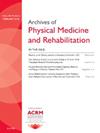非侵入性经脊髓刺激对不完全脊髓损伤后脊髓兴奋性的神经调节作用:一项纵向先导研究
IF 3.6
2区 医学
Q1 REHABILITATION
Archives of physical medicine and rehabilitation
Pub Date : 2025-04-01
DOI:10.1016/j.apmr.2025.01.079
引用次数: 0
摘要
目的探讨不完全性脊髓损伤(SCI)后无创经脊髓刺激(TSS)对脊髓兴奋性的影响。作为临床试验的一部分,在21周的时间内,在3个不同的时间点捕获designmep。参与者被分配到远程医疗家庭培训课程,接受宫颈TSS,前臂电诱发血流量限制运动和特定任务训练,每周3次,持续16周。SettingHome-based培训。4例慢性不完全性脊髓损伤(AIS B-D)患者,年龄37±14.6岁,受伤时间2-23年,被招募作为临床试验的一部分。在C3-C4和C6-C7棘突之间放置两个25mm的阴极电极。在锁骨两侧放置两个矩形电极(5 × 10cm)。测试在基线1 (BL1;基线2 (BL2;BL1后4周),干预后1 (P1;BL2后16周)。最初的4周用于教育参与者及其护理人员安全使用刺激单元(Ex4, Richmar)在家设置。在训练前、训练中和训练后都监测了血压。MEP测量采用1 Hz的刺激频率,2 msec的双相脉冲,刺激强度从1 mA增加到40 mA。MEP数据是通过无线TRINGO EMG传感器收集的,该传感器放置在双侧的三头肌、二头肌、腕屈肌和腕伸肌上。在归一化到最大MEP振幅与刺激强度后,绘制所有肌肉在BL1、BL2和P1的恢复曲线。采用玻尔兹曼s型函数计算招募曲线的斜率。结果与BL1和BL2相比,在P1处绘制的肱三头肌、二头肌和腕屈肌的恢复曲线显示出明显的左移,并有趋于平稳的趋势。相反,随着刺激强度的增加,腕伸肌的招募曲线呈现非平台性上升。最后,达到运动阈值所需的刺激强度在研究过程中逐渐降低。结论TSS的神经调节作用和颈神经回路的兴奋性增加可能增强不完全性脊髓损伤患者的神经可塑性和运动控制功能的恢复。随着时间的推移,腕伸肌曲线的行为可能代表肌腱固定模式的往复,以发展更自然的抓握。本文章由计算机程序翻译,如有差异,请以英文原文为准。
Neuromodulatory Effects of Non-invasive Transspinal Stimulation on Spinal Excitability After Incomplete Spinal Cord Injury: A Longitudinal Pilot Study
Objectives
To study the changes in spinal excitability after noninvasive transspinal stimulation (TSS) after incomplete spinal cord injury (SCI).
Design
MEPs were captured at 3 different timepoints over a period of 21 weeks as a part of a clinical trial. Participants were assigned to a telehealth-home training sessions to undergo cervical TSS, fore-arm electrically evoked blood flow restricted exercise and task-specific training 3 times weekly for 16 weeks.
Setting
Home-based training.
Participants
Four participants with chronic incomplete SCI (AIS B-D), with an age range of 37±14.6 years and time since injury of 2-23 years, were recruited as a part of a clinical trial.
Interventions
Two cathodal electrodes (25mm) were placed between interspinous processes of C3-C4 and C6-C7. Two rectangular electrodes (5 × 10cm) were placed bilaterally over the clavicles. Testing was done at baseline 1 (BL1; before the study), baseline 2 (BL2; 4wk after BL1), and postintervention 1 (P1; 16wk after BL2). The initial 4 weeks were used to educate the participants and their caregivers to safely use the stimulation unit (Ex4, Richmar) at-home setting. Blood pressure was monitored before, during and after the training session. MEP was measured using a stimulation frequency of 1 Hz, a biphasic pulse of 2 msec, and stimulation intensity increased from 1 to 40 mA. MEP data were collected using wireless TRINGO EMG sensors that were placed bilaterally on triceps, biceps, wrist flexor and wrist extensor muscles.
Main Outcome Measures
Recruitment curves were plotted for all muscles at BL1, BL2, and P1 after being normalized to the maximum MEP amplitude versus stimulation intensity. The Boltzmann sigmoidal function was used to calculate the slope of the recruitment curves.
Results
Compared with BL1 and BL2, recruitment curves plotted at P1 for the triceps, biceps, and wrist flexor muscles revealed a noticeable left shift with a trend toward plateauing. Conversely, the recruitment curve of the wrist extensors displayed a nonplateau rise with increasing the stimulation intensity. Finally, the stimulation intensity required to achieve motor threshold decreased over the course of the study.
Conclusions
The findings highlight the neuromodulation effects of TSS and increased excitability of the cervical neural circuitries, which may subsequently enhance neuroplasticity and restoration of motor control in persons with incomplete SCI. The behavior of the wrist extensors curve over time may represent reciprocation of the tenodesis pattern to develop a more natural grasp.
Disclosures
none.
求助全文
通过发布文献求助,成功后即可免费获取论文全文。
去求助
来源期刊
CiteScore
6.20
自引率
4.70%
发文量
495
审稿时长
38 days
期刊介绍:
The Archives of Physical Medicine and Rehabilitation publishes original, peer-reviewed research and clinical reports on important trends and developments in physical medicine and rehabilitation and related fields. This international journal brings researchers and clinicians authoritative information on the therapeutic utilization of physical, behavioral and pharmaceutical agents in providing comprehensive care for individuals with chronic illness and disabilities.
Archives began publication in 1920, publishes monthly, and is the official journal of the American Congress of Rehabilitation Medicine. Its papers are cited more often than any other rehabilitation journal.

 求助内容:
求助内容: 应助结果提醒方式:
应助结果提醒方式:


